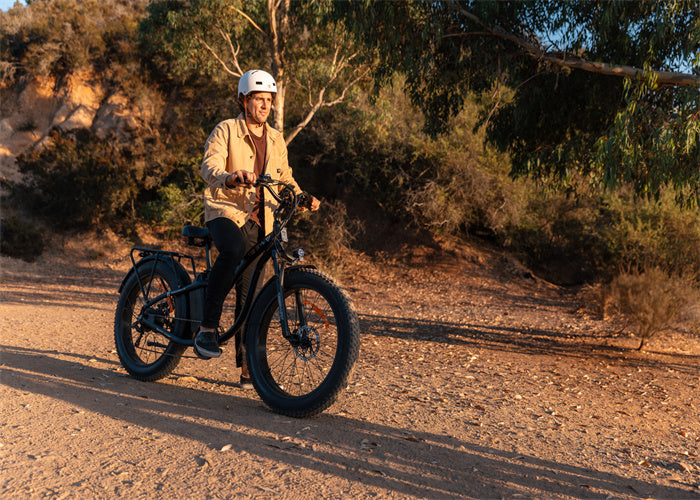Fat electric bikes are a specific category of e-bikes characterized by their oversized tires, typically ranging from 3.8 inches to 5 inches wide.
These tires are designed to offer exceptional stability and traction on various surfaces, including sand, snow, mud, and rough terrains.
The extra surface area of the tires allows the bike to "float" over soft or uneven ground, making it a versatile option for outdoor enthusiasts.
Advantages of Fat E-Bikes for Touring
1. Superior Traction and Stability
One of the most significant advantages of a fat e-bike is its superior traction and stability.
Whether you're riding on loose gravel, wet leaves, or snowy trails, the wide tires grip the ground with confidence.
This enhanced stability makes fat e-bikes particularly suitable for touring in diverse environments where road conditions may be unpredictable.
2. Comfort Over Long Distances
Touring often involves spending several hours on the saddle each day.
Fat e-bikes, with their larger tires, naturally absorb more shocks and vibrations from the ground compared to standard e-bikes.
This results in a smoother and more comfortable ride over long distances, reducing the fatigue and discomfort that can come from prolonged periods of cycling.
3. Versatility in Terrain
Fat e-bikes are incredibly versatile when it comes to the types of terrain they can conquer.
Whether you're planning a tour that takes you through mountain trails, sandy beaches, or snowy landscapes, a fat e-bike can handle it all.
This versatility is particularly beneficial for touring, where the ability to adapt to different terrains without needing to switch bikes can be a game-changer.
4. Increased Load Capacity
Touring often requires carrying a significant amount of gear, from camping equipment to food supplies.
Fat e-bikes, with their robust frames and powerful motors, typically offer a higher load capacity than their slimmer counterparts.
This means you can carry everything you need for an extended tour without compromising on performance or stability.

SEE ALSO 11 Disadvantages of Fold-up Electric Bikes
Disadvantages of Fat E-Bikes for Touring
1. Increased Weight
The additional weight of the wide tires and the sturdy frame needed to support them is one of the primary drawbacks of fat e-bikes.
This increased weight can make the bike more challenging to handle, particularly in situations where you need to lift or carry the bike, such as loading it onto a vehicle or navigating steep inclines without motor assistance.
2. Lower Battery Efficiency
Fat e-bikes generally require more power to maintain speed and maneuver due to the extra drag from the wide tires.
This can result in lower battery efficiency, meaning you may need to recharge more frequently during your tour.
For long-distance tours, this could be a limiting factor, especially if you're traveling through remote areas where charging options are scarce.
3. Limited Speed and Agility
The design of fat e-bikes, optimized for stability and traction, often comes at the expense of speed and agility.
Fat e-bikes are typically slower than other e-bike types, which might be a consideration if you prefer to cover more ground quickly.
Additionally, the wider turning radius and bulkier build can make navigating tight spaces or crowded urban areas more challenging.
4. Tire Pressure Sensitivity
Fat bike tires operate at much lower pressures than standard bike tires, usually around 5-15 PSI.
While this low pressure is excellent for off-road traction, it also means that the tires are more susceptible to pressure changes, which can impact performance.
Managing tire pressure becomes crucial, especially when transitioning between different types of terrain during a tour.

Best Use Cases for Fat E-Bike Touring
Given the unique characteristics of fat e-bikes, they are best suited for specific types of touring:
Off-Road and Mixed-Terrain Tours
If your touring route includes extensive off-road sections, such as trails, forests, deserts, or beaches, a fat e-bike is an ideal choice.
Its ability to handle a variety of surfaces with ease makes it perfect for adventurous tours that venture beyond paved roads.
Winter Touring
For those who love winter adventures, fat e-bikes excel in snowy conditions.
The wide tires provide the necessary traction to ride on snow-covered trails, making them an excellent option for winter touring. This capability opens up opportunities to tour in regions and seasons where other bikes might struggle.
Heavy Load Touring
When your tour involves carrying a substantial load, whether it's due to a long duration or the need for extensive gear, the increased load capacity of a fat e-bike is a significant advantage.
The sturdy frame and powerful motor ensure that you can transport your gear without worrying about stability or performance issues.
Leisurely Pace Tours
If your touring style leans more towards enjoying the journey rather than racing to the destination, the slower pace and comfort of a fat e-bike might be exactly what you need.
This makes fat e-bikes a great option for tours focused on sightseeing, photography, or simply soaking in the natural surroundings.
Wrapping Up
Fat e-bike can be an excellent choice for touring, provided that the type of tour aligns with the strengths of the bike.
If your tour involves mixed terrains, heavy loads, or winter conditions, a fat e-bike offers unparalleled stability, comfort, and versatility. However, if speed, battery efficiency, and maneuverability are higher priorities, you might want to consider other types of e-bikes.
The decision should be based on the specific requirements of your tour and your personal preferences. Fat e-bikes open up a world of possibilities for adventurous tours, but they do come with trade-offs that need to be carefully considered.
FAQs
How do I maintain the tire pressure on a fat e-bike?
Maintaining the correct tire pressure on a fat e-bike is crucial for optimal performance. Use a low-pressure gauge to check the tire pressure regularly, especially when changing terrains. Adjust the pressure according to the surface you’ll be riding on to ensure the best traction and ride comfort.
Are fat e-bikes more expensive than regular e-bikes?
Fat e-bikes can be more expensive than standard e-bikes due to the larger tires, reinforced frames, and powerful motors required to handle various terrains. However, the cost is often justified by the added versatility and durability.
Do fat e-bikes require special maintenance?
Fat e-bikes require similar maintenance to regular e-bikes, but with extra attention to the tires and rims due to the low-pressure requirements. Regular checks on tire pressure, brake pads, and motor performance are essential to keep the bike in top condition.







Share:
Complete Guide to Regular Electric Bike Inspection and Maintenance
Get More Miles! Tips for Increasing Your Electric Bike's Range